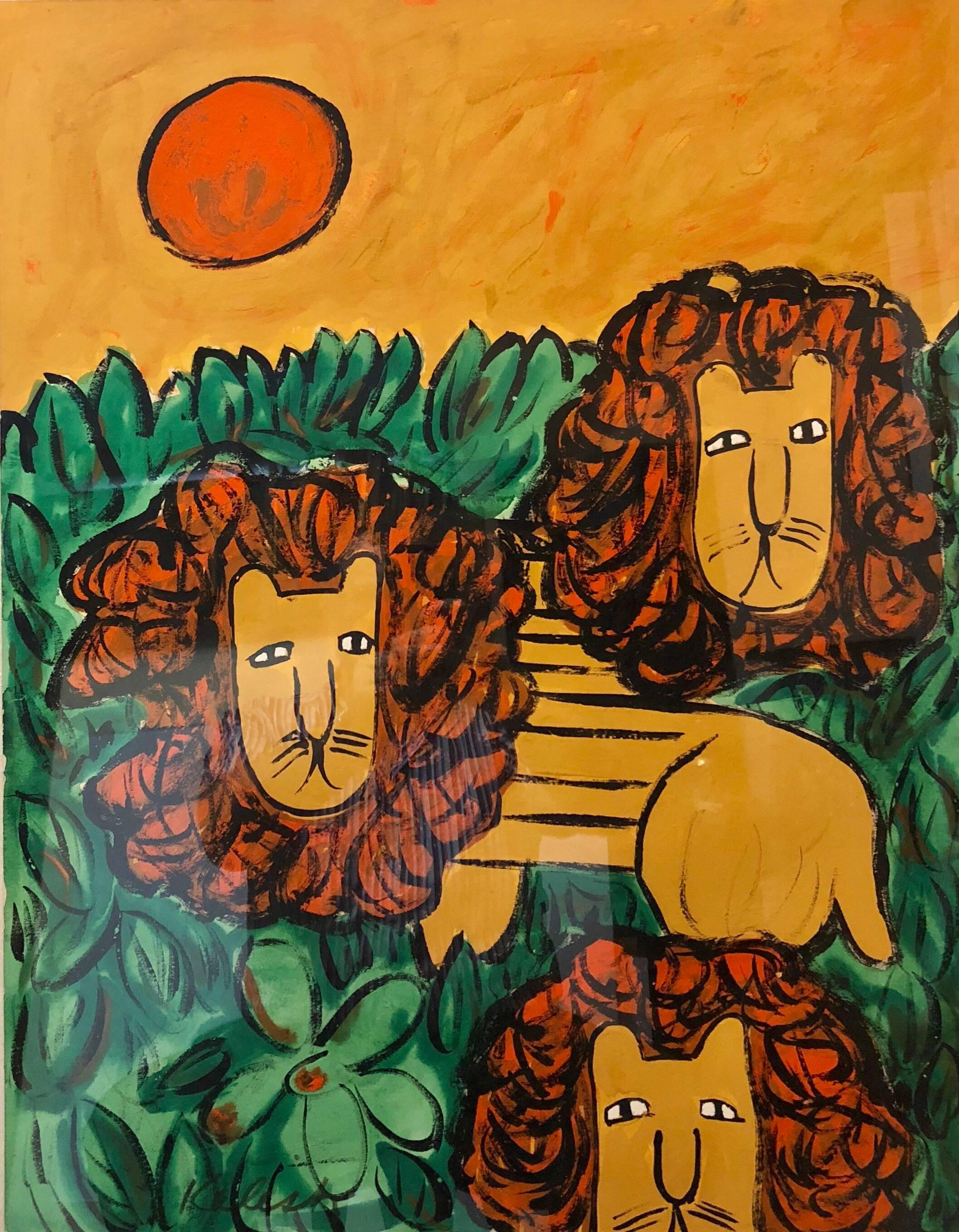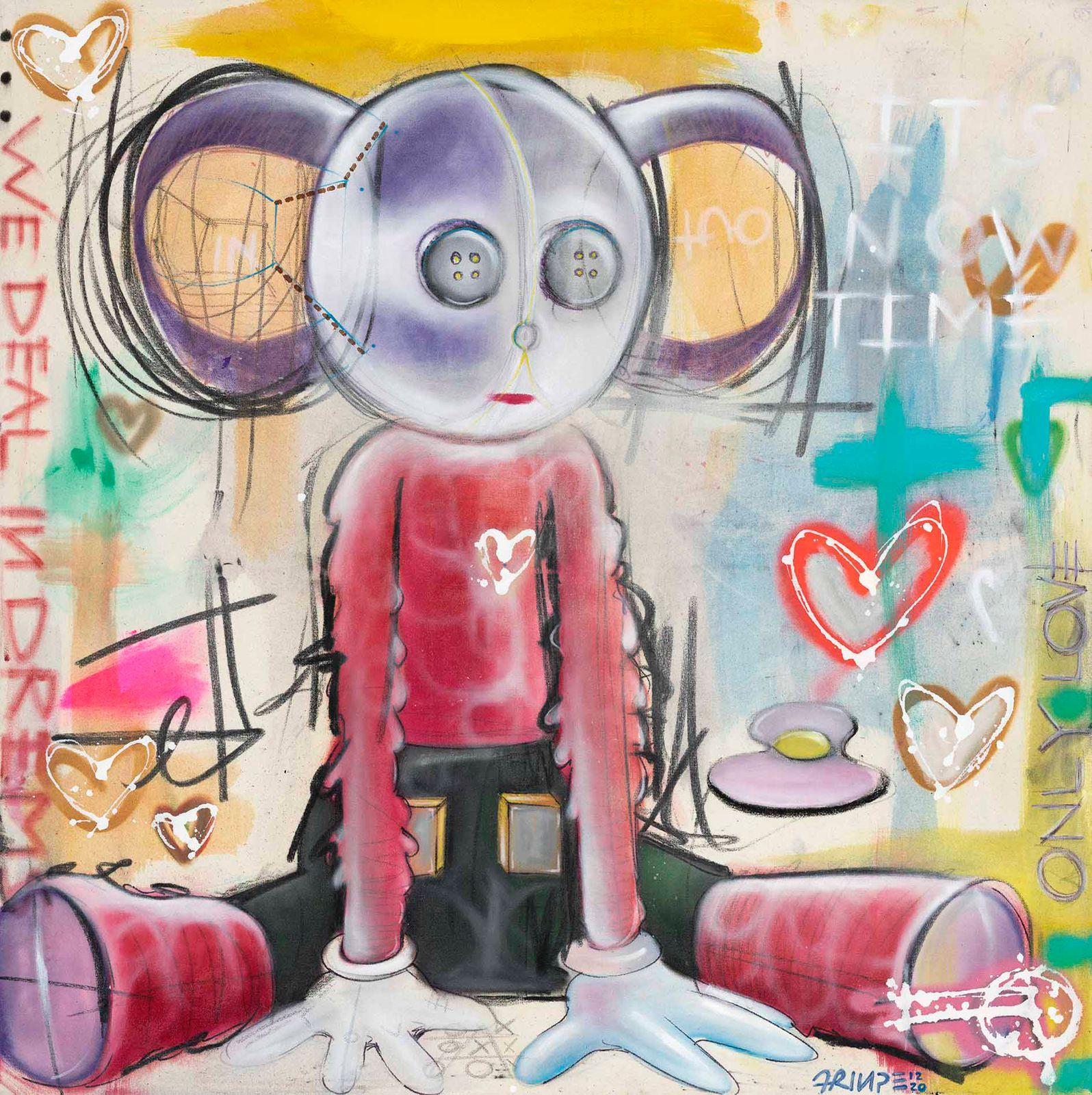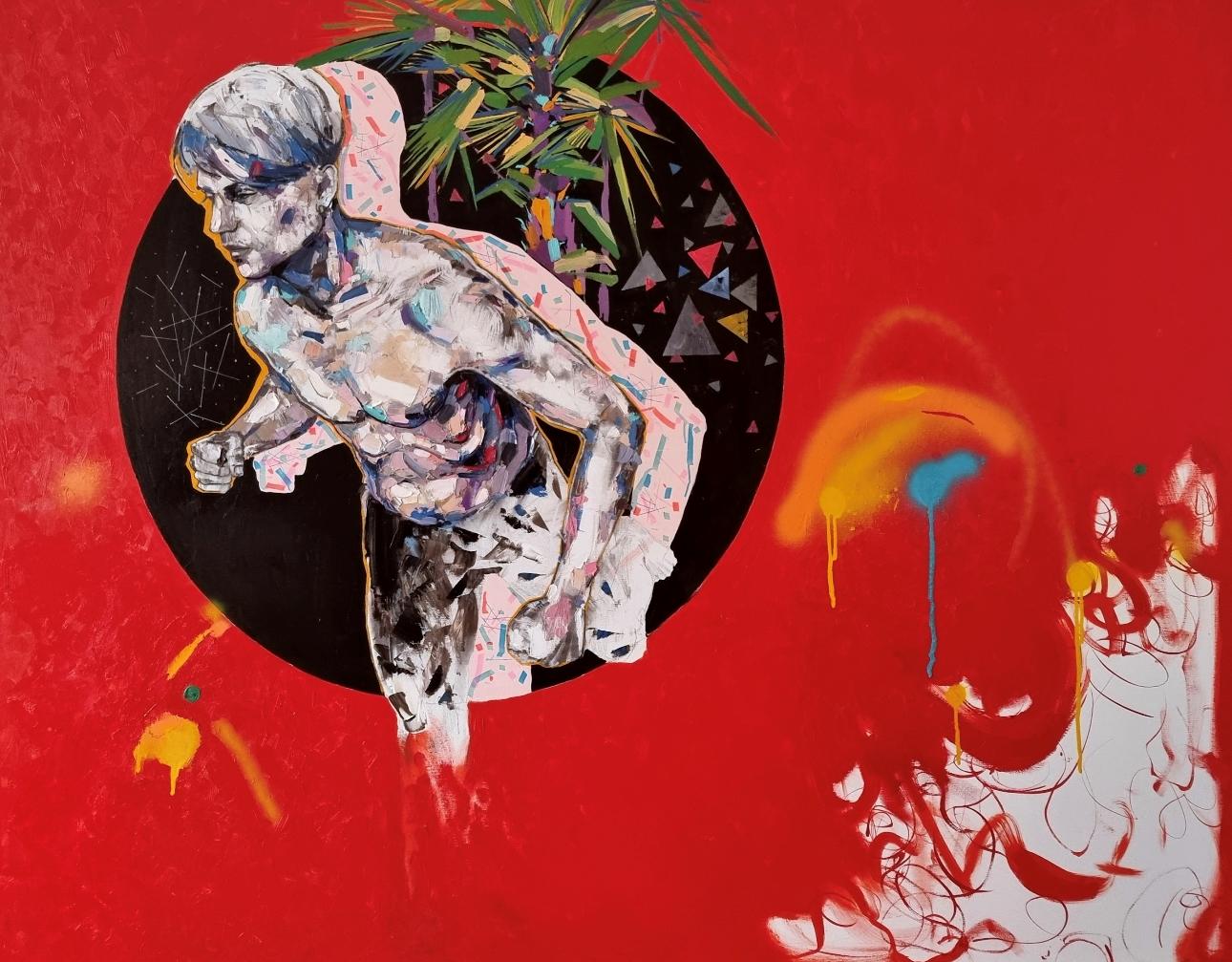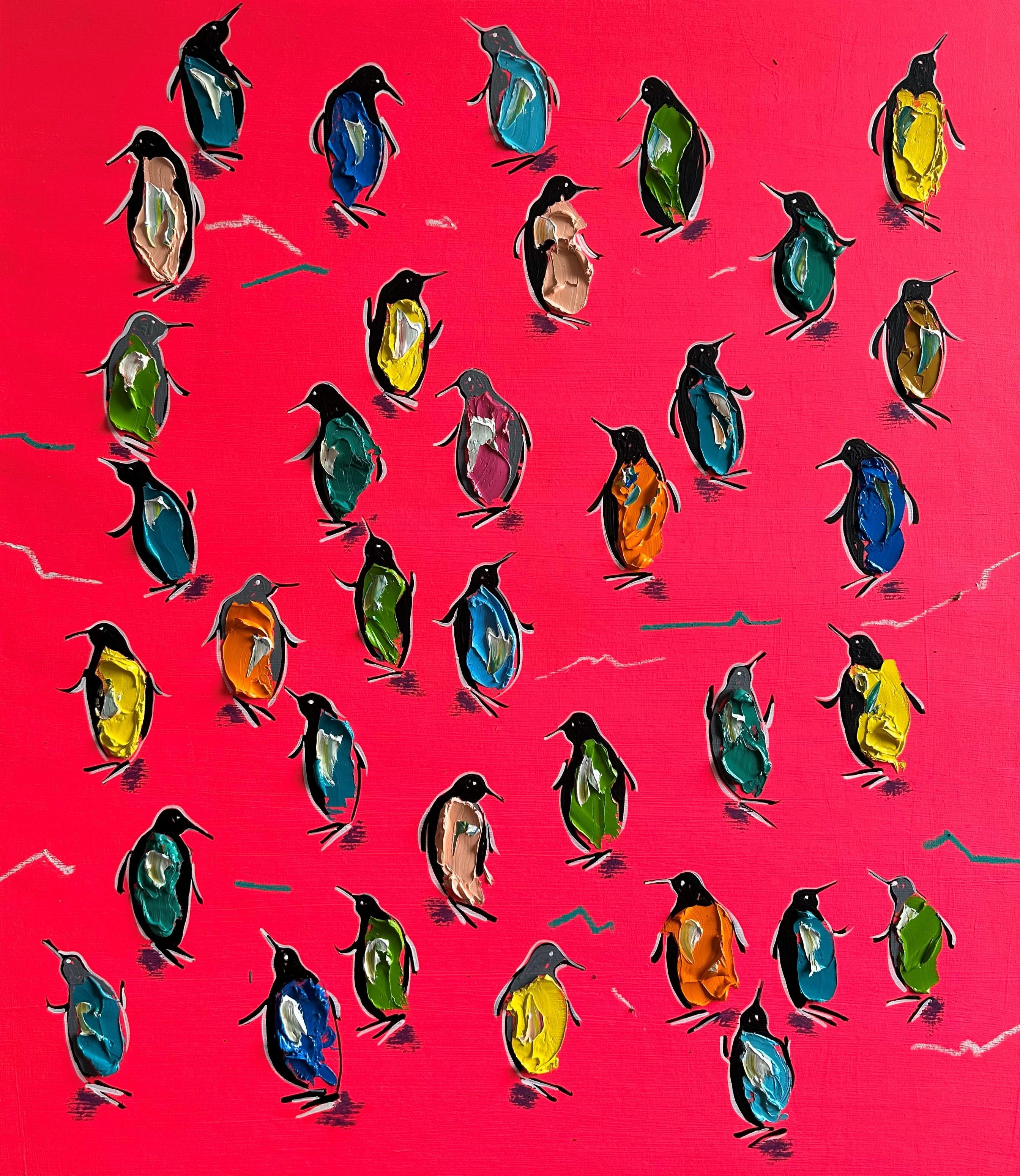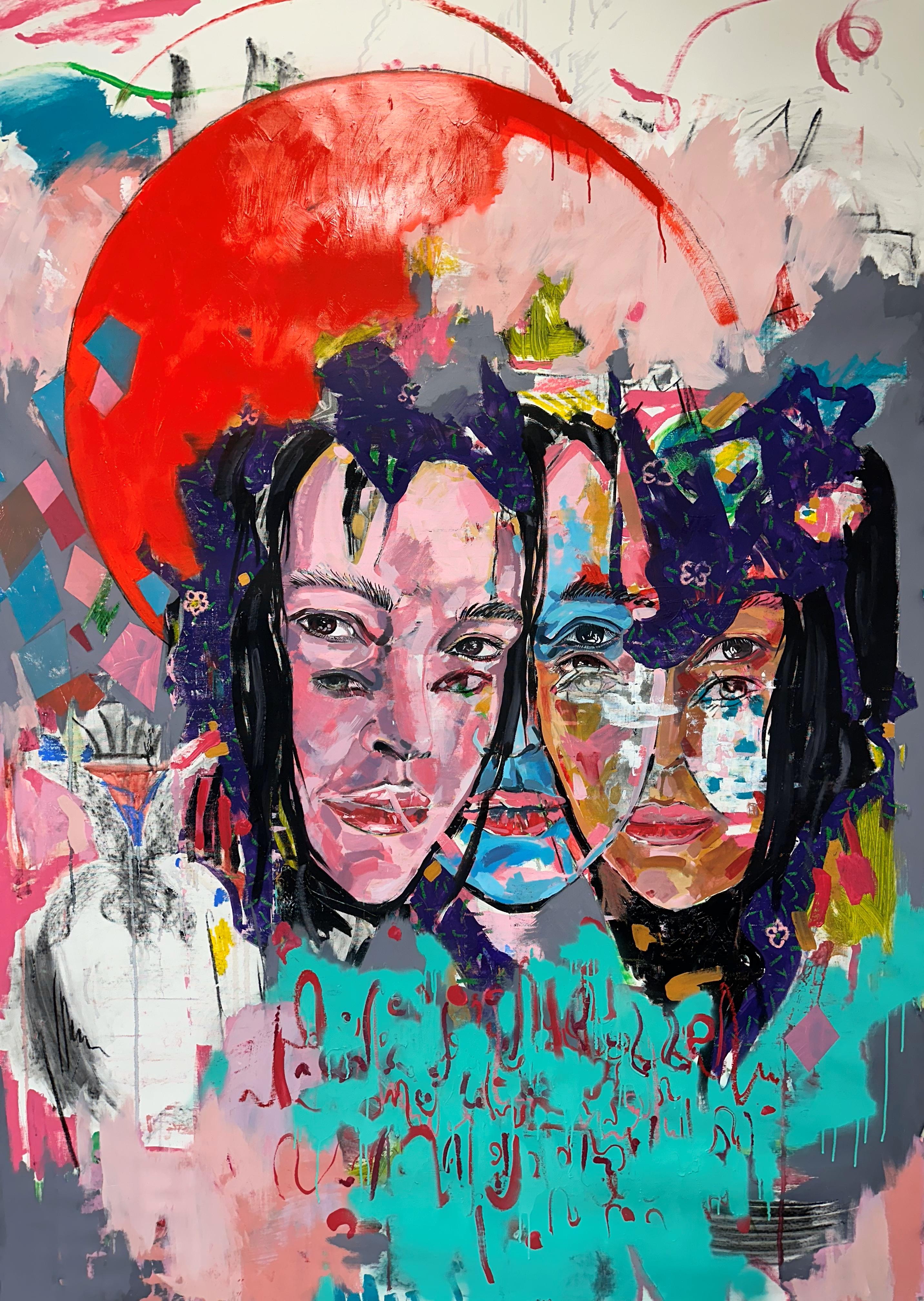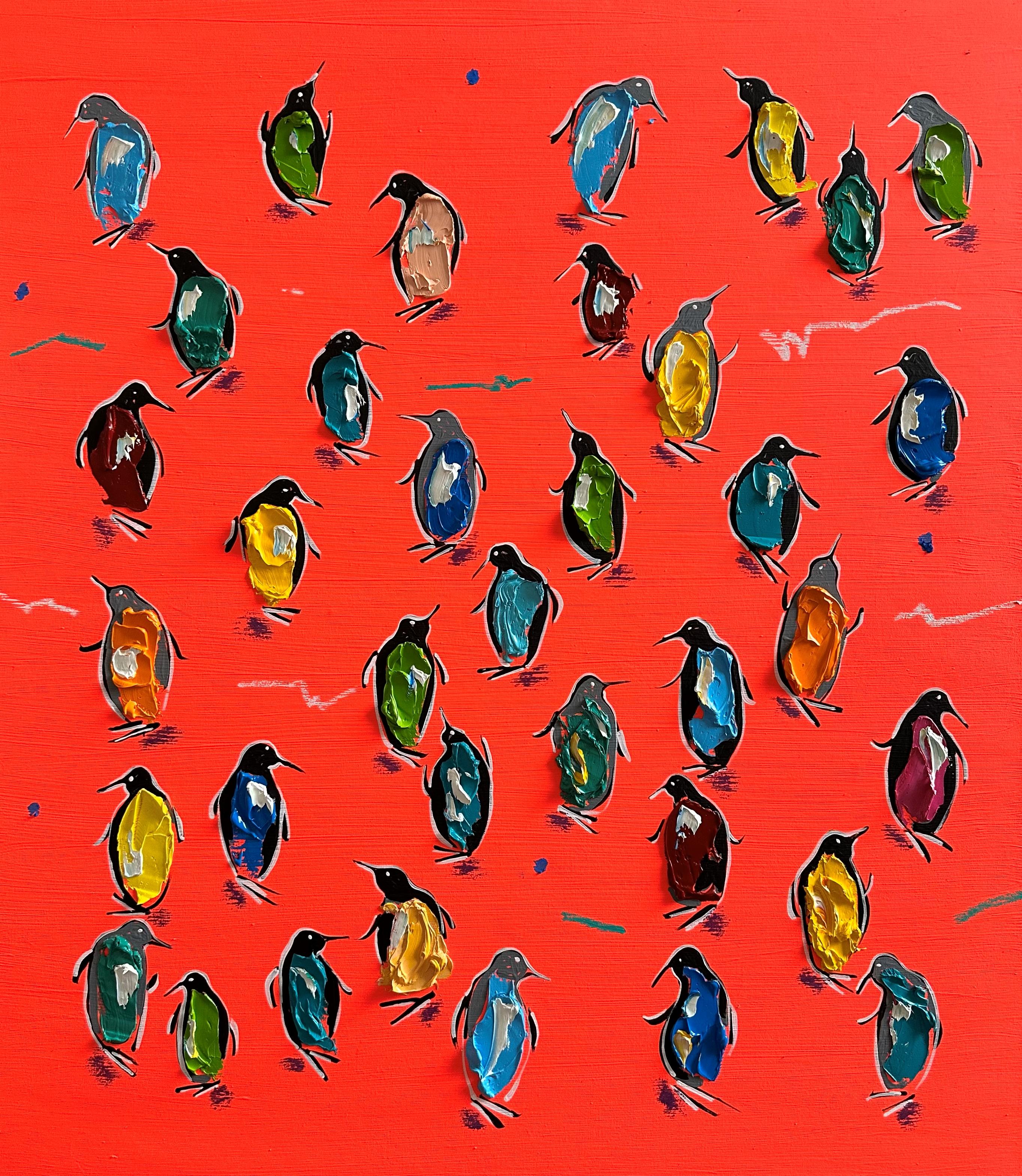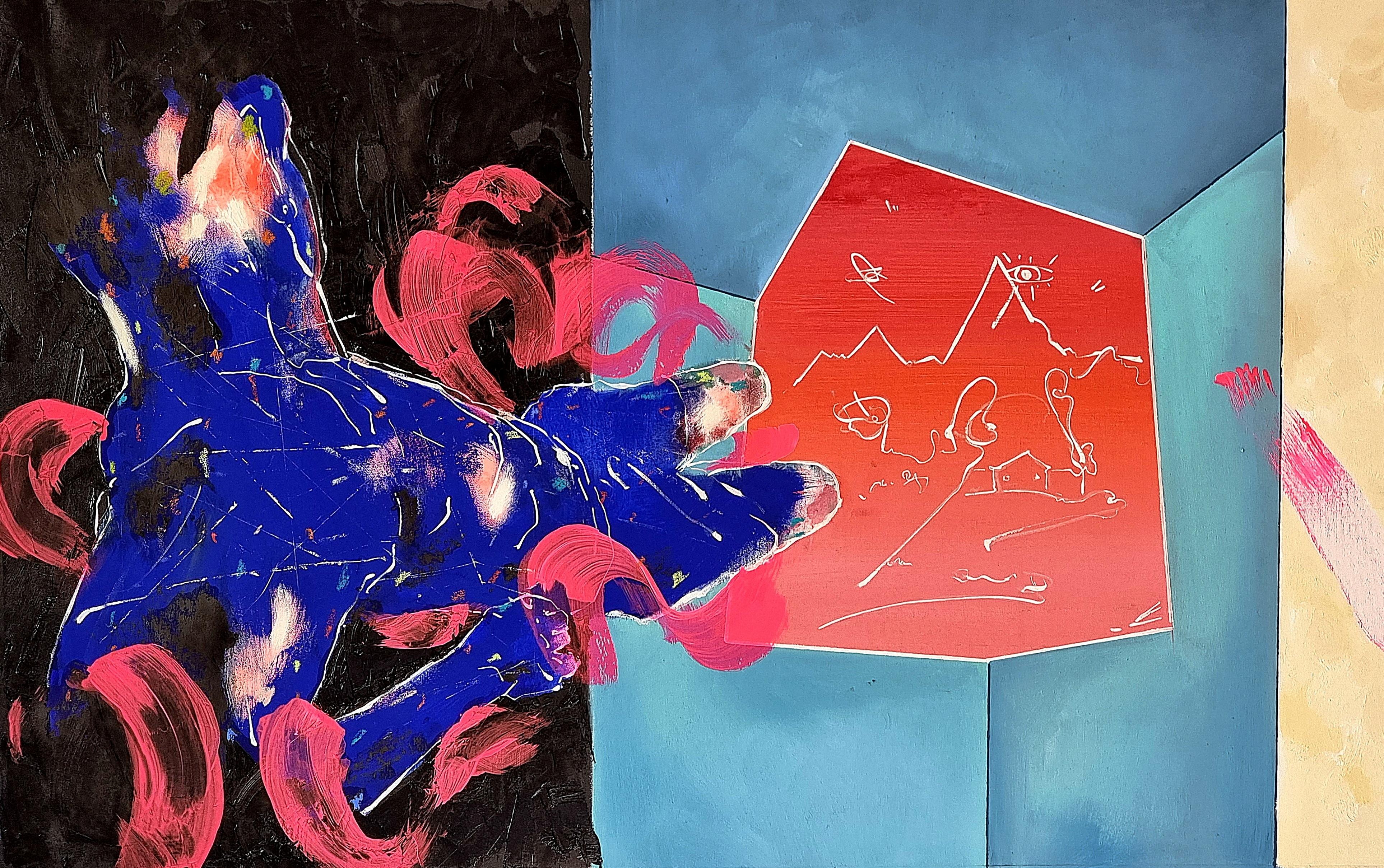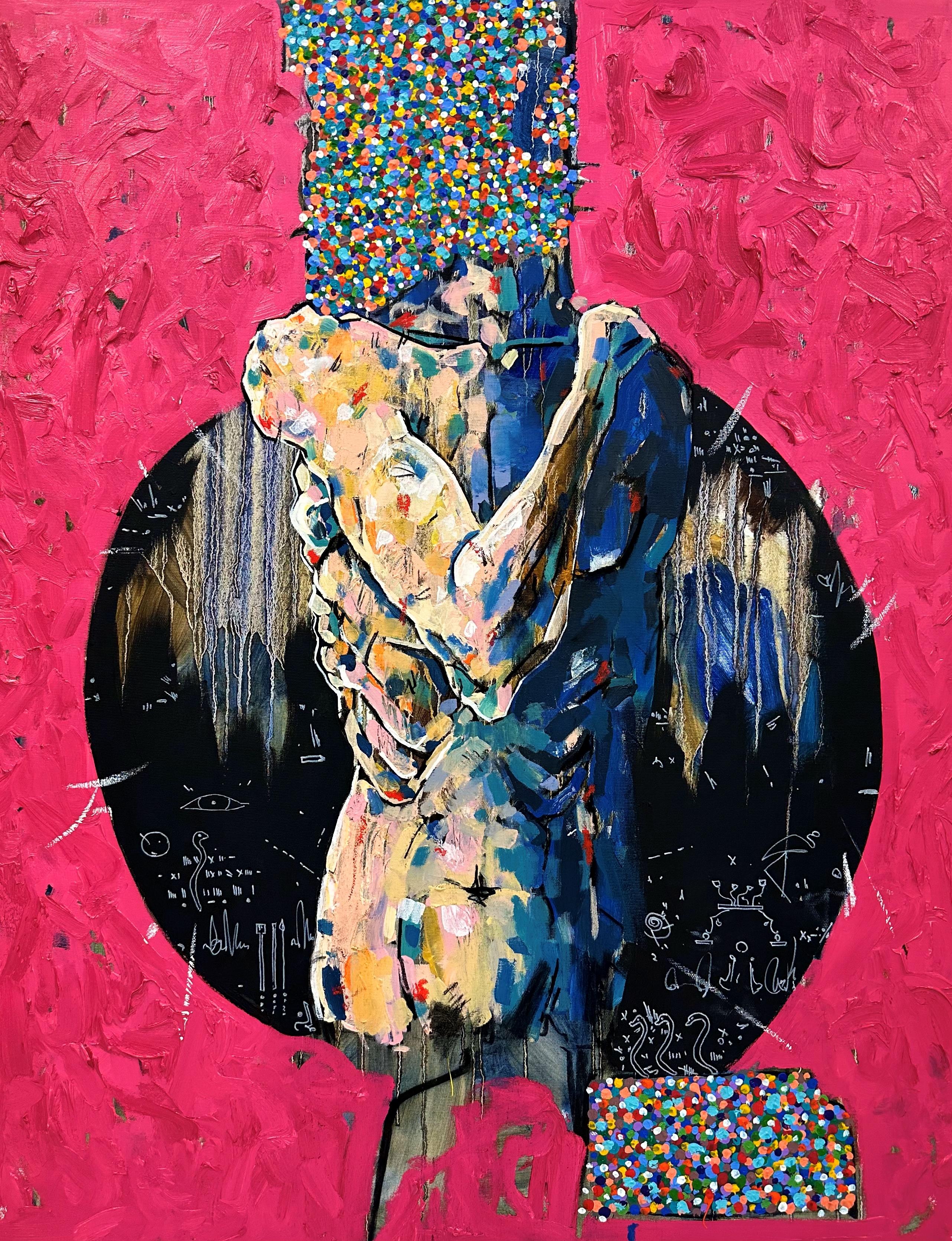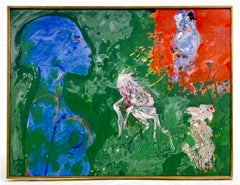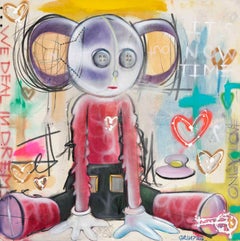
Original Oil Painting LIONS in a Modernist Illustration Mod Naive Graphic Style
View Similar Items
Lionel KalishOriginal Oil Painting LIONS in a Modernist Illustration Mod Naive Graphic Stylec.1960s
c.1960s
About the Item
- Creator:Lionel Kalish (1931, American)
- Creation Year:c.1960s
- Dimensions:Height: 33.5 in (85.09 cm)Width: 27 in (68.58 cm)
- Medium:
- Movement & Style:
- Period:
- Condition:needs new mat and frame. staining to mat lower right does not affect image.
- Gallery Location:Surfside, FL
- Reference Number:1stDibs: LU3822616223
- Original Oil Painting LIONS in a Modernist Illustration Mod Naive Graphic StyleLocated in Surfside, FL33.5x27, sight size 28x22 Lionel Kalish born 1931 New York, NY A painter and childrens book illustrator. Education: 1951 Cooper Union of the Advancement of Science and Art, New York, NY Selected Solo Exhibitions: 1978 Forum Gallery, New York, NY 1980 Galerie Brusberg, Hannover, Germany 1981 ACA Galleries, New York, NY 1982 Galerie Stubler, Frankfurt Germany 1984 Galerie Brusberg, Berlin, Germany 1990 Sid Detuch Gallery, New York, NY 1994 Lewis Newman Galleries, Beverly Hills, CA Galerie Brusberg, Berlin, Germany 1996 The Horwitch Newman Gallery, “Italy: The Poetry of Landscape,” Scottsdale, AZ Gremillion & Co. Fine Arts, “Italy: The Timeless Landscape,” Houston, TX 1997 Hoorn-Hashby Gallery, “Color and Light: The Italian Façade...Category
1960s Pop Art Animal Paintings
MaterialsPaper, Oil
- Large Ralph Massey California Pop Art Painting Vintage Americana, Toys Old CarsLocated in Surfside, FLARTIFACTS, 2015, Acrylic painting on paper artist mounted to panel, Hand signed and dated right side Dimensions: 24 x 43 x 1 ¾” This depicts an old cast iron Mickey Mouse, Felix the Cat, an old tin can of pop corn and other vintage, nostalgic, Americana. Born in 1938, Ralph Allen Massey is a talented American artist, sculptor and jewelry designer. Prior to the 1980s, in his work he preferred sculpture. However, in the early 1980s, together with the artist Sylvia Bennett, he opened the art studio “Raven”. using his creativity, has become the creation of jewelry decorations and jewelry boxes. An interesting collection was “Wildlife”, brooches, earrings and rings in the form of animals and birds. Also, no less interesting was the line of jewellery inspired by the characters of the books “Alice in Wonderland...Category
21st Century and Contemporary Pop Art Figurative Paintings
MaterialsAcrylic, Wood Panel, Laid Paper
- American Neo Expressionist Woman with Monkeys Abstract Modernist Oil PaintingBy Robert BeauchampLocated in Surfside, FLRobert Beauchamp, American (1923-1995) Untitled Hand signed lower right, titled verso. MIxed media oil painting on heavy art paper sight: 22 3/4 x 29 1/2 inches frame dimensions: 23 1/4 x 30 1/4 x 1 1/4 inches, metal frame with glazing Provenance: Private Collection. Frame inscribed 'Property of AT&T' Bears label from their corporate art collection. Robert Beauchamp (1923 – March 1995) was an American figurative painter and arts educator. Beauchamp's paintings and drawings are known for depicting dramatic creatures and figures with expressionistic colors. His work was described in the New York Times as being "both frightening and amusing,". He was a Guggenheim Fellow and a student of Hans Hofmann. Robert Beauchamp was born in Denver, Colorado in 1923. He had three brothers and three sisters, and the children were orphaned by both parents by the time Beauchamp was three. The family grew up impoverished due to the Great Depression, living in a community house with other families. As a child he dabbled in art but it wasn't until high school that he began taking art classes. When not creating art he also played sports; football and basketball, and enjoyed chemistry and geology. He was told he was good at drawing, and replaced study hall classes with art classes, receiving instruction and inspiration from a Welsh teacher named R. Idris Thomas. While in high school Beauchamp would go, every Monday, to the public library and a local museum where he would read books about art; specifically French painting, as assigned by Thomas. Beauchamp absorbed the tenets of European Modernism and American Abstract Expressionism—with which he eventually broke. While abstraction, with its focus on color and form, underlies his compositions, he filled canvas and paper with psychologically acute portraits of himself and others, nudes, animals, and objects of all kinds. Beauchamp would spend upwards of four hours a day in the art room and eventually won the Carter Memorial Prize, which provided a scholarship to the Colorado Springs Fine Arts Center. At Colorado Springs he studied under Boardman Robinson, painting landscapes in nature. Beauchamp eventually joined the Navy and then returned to Colorado Springs to continue his studies. Traveling the world as an Armed Guard, he spent a year and a half at sea and the rest of the three years in San Francisco. Seeking to make money, and to follow his love for a girl, Beauchamp decided to attend Cranbrook Academy of Art from 1947–1948. There he studied pottery, believing one could "make more money selling pots than you could selling paintings." He described his experience at Cranbrook as intimidating and claustrophobic, and eventually switched to sculpture before switching to painting. Beauchamp moved to New York City in the early 1950s and was involved in the Tenth Street galleries, which provided outlets for more experimental artists and the second generation of abstract expressionists. Despite his involvement with 10th Street and friendships with abstract artists, abstract art never interested in him. He showed at numerous galleries in New York and Provincetown, socializing with gallery owners, artists and collectors. His first exhibition was at the Tanager Gallery in New York, he also showed during the 1950s at the Hansa Gallery. In New York and Provincetown he studied under Hans Hofmann Eventually he felt that abstract expressionism became dull and stalemated. During the 1960s he showed at the Green Gallery. C. 1960 he was awarded a Fulbright Award allowing him to travel to La Romola, Italy. He traveled frequently to cities such as Rome and worked constantly. Beauchamp returned to the states and lived in Provincetown at Walter Gutman...Category
20th Century Neo-Expressionist Abstract Paintings
MaterialsPaper, Oil
- American Neo Expressionist Woman with Camels Abstract Modernist Oil PaintingBy Robert BeauchampLocated in Surfside, FLHand signed lower right, titled verso. Blue Woman with Seated Camels MIxed media oil painting on heavy art paper Robert Beauchamp (1923 – March 1995) was an American figurative painter and arts educator. Beauchamp's paintings and drawings are known for depicting dramatic creatures and figures with expressionistic colors. His work was described in the New York Times as being "both frightening and amusing,". He was a Guggenheim Fellow and a student of Hans Hofmann. Robert Beauchamp was born in Denver, Colorado in 1923. He had three brothers and three sisters, and the children were orphaned by both parents by the time Beauchamp was three. The family grew up impoverished due to the Great Depression, living in a community house with other families. As a child he dabbled in art but it wasn't until high school that he began taking art classes. When not creating art he also played sports; football and basketball, and enjoyed chemistry and geology. He was told he was good at drawing, and replaced study hall classes with art classes, receiving instruction and inspiration from a Welsh teacher named R. Idris Thomas. While in high school Beauchamp would go, every Monday, to the public library and a local museum where he would read books about art; specifically French painting, as assigned by Thomas. Beauchamp absorbed the tenets of European Modernism and American Abstract Expressionism—with which he eventually broke. While abstraction, with its focus on color and form, underlies his compositions, he filled canvas and paper with psychologically acute portraits of himself and others, nudes, animals, and objects of all kinds. Beauchamp would spend upwards of four hours a day in the art room and eventually won the Carter Memorial Prize, which provided a scholarship to the Colorado Springs Fine Arts Center. At Colorado Springs he studied under Boardman Robinson, painting landscapes in nature. Beauchamp eventually joined the Navy and then returned to Colorado Springs to continue his studies. Traveling the world as an Armed Guard, he spent a year and a half at sea and the rest of the three years in San Francisco. Seeking to make money, and to follow his love for a girl, Beauchamp decided to attend Cranbrook Academy of Art from 1947–1948. There he studied pottery, believing one could "make more money selling pots than you could selling paintings." He described his experience at Cranbrook as intimidating and claustrophobic, and eventually switched to sculpture before switching to painting. Beauchamp moved to New York City in the early 1950s and was involved in the Tenth Street galleries, which provided outlets for more experimental artists and the second generation of abstract expressionists. Despite his involvement with 10th Street and friendships with abstract artists, abstract art never interested in him. He showed at numerous galleries in New York and Provincetown, socializing with gallery owners, artists and collectors. His first exhibition was at the Tanager Gallery in New York, he also showed during the 1950s at the Hansa Gallery. In New York and Provincetown he studied under Hans Hofmann Eventually he felt that abstract expressionism became dull and stalemated. During the 1960s he showed at the Green Gallery. C. 1960 he was awarded a Fulbright Award allowing him to travel to La Romola, Italy. He traveled frequently to cities such as Rome and worked constantly. Beauchamp returned to the states and lived in Provincetown at Walter Gutman...Category
20th Century Neo-Expressionist Abstract Paintings
MaterialsPaper, Oil
- American Neo Expressionist "Wild Horses" Modernist Oil PaintingBy Robert BeauchampLocated in Surfside, FLSigned lower left. Robert Beauchamp (1923 – March 1995) was an American figurative painter and arts educator. Beauchamp's paintings and drawings are known for depicting dramatic creatures and figures with expressionistic colors. His work was described in the New York Times as being "both frightening and amusing,". He was a Guggenheim Fellow and a student of Hans Hofmann. Robert Beauchamp was born in Denver, Colorado in 1923. He had three brothers and three sisters, and the children were orphaned by both parents by the time Beauchamp was three. The family grew up impoverished due to the Great Depression, living in a community house with other families. As a child he dabbled in art but it wasn't until high school that he began taking art classes. When not creating art he also played sports; football and basketball, and enjoyed chemistry and geology. He was told he was good at drawing, and replaced study hall classes with art classes, receiving instruction and inspiration from a Welsh teacher named R. Idris Thomas. While in high school Beauchamp would go, every Monday, to the public library and a local museum where he would read books about art; specifically French painting, as assigned by Thomas. Beauchamp absorbed the tenets of European Modernism and American Abstract Expressionism—with which he eventually broke. While abstraction, with its focus on color and form, underlies his compositions, he filled canvas and paper with psychologically acute portraits of himself and others, nudes, animals, and objects of all kinds. Beauchamp would spend upwards of four hours a day in the art room and eventually won the Carter Memorial Prize, which provided a scholarship to the Colorado Springs Fine Arts Center. At Colorado Springs he studied under Boardman Robinson, painting landscapes in nature. Beauchamp eventually joined the Navy and then returned to Colorado Springs to continue his studies. Traveling the world as an Armed Guard, he spent a year and a half at sea and the rest of the three years in San Francisco. Seeking to make money, and to follow his love for a girl, Beauchamp decided to attend Cranbrook Academy of Art from 1947–1948. There he studied pottery, believing one could "make more money selling pots than you could selling paintings." He described his experience at Cranbrook as intimidating and claustrophobic, and eventually switched to sculpture before switching to painting. Beauchamp moved to New York City in the early 1950s and was involved in the Tenth Street galleries, which provided outlets for more experimental artists and the second generation of abstract expressionists. Despite his involvement with 10th Street and friendships with abstract artists, abstract art never interested in him. He showed at numerous galleries in New York and Provincetown, socializing with gallery owners, artists and collectors. His first exhibition was at the Tanager Gallery in New York, he also showed during the 1950s at the Hansa Gallery. In New York and Provincetown he studied under Hans Hofmann Eventually he felt that abstract expressionism became dull and stalemated. During the 1960s he showed at the Green Gallery. C. 1960 he was awarded a Fulbright Award allowing him to travel to La Romola, Italy. He traveled frequently to cities such as Rome and worked constantly. Beauchamp returned to the states and lived in Provincetown at Walter Gutman's house, who awarded Beauchamp a grant. That year he met his future wife, Nadine Valenti, whom he married in 1967. Beauchamp taught at a variety of schools during his lifetime including Brooklyn College, School of Visual Arts, Cooper Union and the Art Students League of New York during the last fifteen years of his life. Beauchamp described his drawings as painterly, seeking the spontaneity in an image. He would develop a drawing then a painting, and vice versa. His heavily impastoed paintings, often described as sculptures themselves, came from the pouring of paint from a can, with little planning and constant evolution in the medium upon the canvas. He preferred little planning to his creations, believing that an artists work would become stale and repetitive with constant planning. He also created large scale works, at times 70 inches long. Beauchamp had little intention of ever selling his large works, preferring to create them due to the slow and intense experience he received from the process. The large drawings he created on the floor, and the smaller works were created on a table. Paintings were created on either the floor or wall and he described his painting process as "splattering", "pushing the paint around," and sponging. Animals often appear in his paintings, despite a dislike for domestic animals outside of his artistic creations. He called the characters in his paintings as Beauchamps. Some Beauchamps hold meaning, with Beauchamp rarely sharing the meaning behind the symbols and characters. He made up the creatures himself, seeking to emphasize the character of each. In 2006 the University of Massachusetts Amherst College of Visual & Performing Arts hosted an exhibition of Beauchamp's pieces from the 1960s, curators stated that Beauchamp's work: "effortlessly blends innovative style elements with narrative, descriptive images. One senses equal enjoyment in the manipulation of, and interaction with, color and paint, and the often sudden and unexpected presence of a wasp or a lump of sugar." included in the important exhibit "Twelve New York Painters." New York: David Findlay Jr. Fine Art with Mary Abbott, Alcopley, Robert Beauchamp, Byron Browne, Charles Cajori, Jim Forsberg, Carl Heidenreich, Angelo Ippolito, Emily Mason, Robert Natkin, Robert Richenburg and Nina Tryggvadottir...Category
20th Century Neo-Expressionist Abstract Paintings
MaterialsPaper, Oil
- American Neo Expressionist "Wild Horses" Modernist Oil PaintingBy Robert BeauchampLocated in Surfside, FLRobert Beauchamp (1923 – March 1995) was an American figurative painter and arts educator. Beauchamp's paintings and drawings are known for depicting dramatic creatures and figures with expressionistic colors. His work was described in the New York Times as being "both frightening and amusing,". He was a Guggenheim Fellow and a student of Hans Hofmann. Robert Beauchamp was born in Denver, Colorado in 1923. He had three brothers and three sisters, and the children were orphaned by both parents by the time Beauchamp was three. The family grew up impoverished due to the Great Depression, living in a community house with other families. As a child he dabbled in art but it wasn't until high school that he began taking art classes. When not creating art he also played sports; football and basketball, and enjoyed chemistry and geology. He was told he was good at drawing, and replaced study hall classes with art classes, receiving instruction and inspiration from a Welsh teacher named R. Idris Thomas. While in high school Beauchamp would go, every Monday, to the public library and a local museum where he would read books about art; specifically French painting, as assigned by Thomas. Beauchamp absorbed the tenets of European Modernism and American Abstract Expressionism—with which he eventually broke. While abstraction, with its focus on color and form, underlies his compositions, he filled canvas and paper with psychologically acute portraits of himself and others, nudes, animals, and objects of all kinds. Beauchamp would spend upwards of four hours a day in the art room and eventually won the Carter Memorial Prize, which provided a scholarship to the Colorado Springs Fine Arts Center. At Colorado Springs he studied under Boardman Robinson, painting landscapes in nature. Beauchamp eventually joined the Navy and then returned to Colorado Springs to continue his studies. Traveling the world as an Armed Guard, he spent a year and a half at sea and the rest of the three years in San Francisco. Seeking to make money, and to follow his love for a girl, Beauchamp decided to attend Cranbrook Academy of Art from 1947–1948. There he studied pottery, believing one could "make more money selling pots than you could selling paintings." He described his experience at Cranbrook as intimidating and claustrophobic, and eventually switched to sculpture before switching to painting. Beauchamp moved to New York City in the early 1950s and was involved in the Tenth Street galleries, which provided outlets for more experimental artists and the second generation of abstract expressionists. Despite his involvement with 10th Street and friendships with abstract artists, abstract art never interested in him. He showed at numerous galleries in New York and Provincetown, socializing with gallery owners, artists and collectors. His first exhibition was at the Tanager Gallery in New York, he also showed during the 1950s at the Hansa Gallery. In New York and Provincetown he studied under Hans Hofmann Eventually he felt that abstract expressionism became dull and stalemated. During the 1960s he showed at the Green Gallery. C. 1960 he was awarded a Fulbright Award allowing him to travel to La Romola, Italy. He traveled frequently to cities such as Rome and worked constantly. Beauchamp returned to the states and lived in Provincetown at Walter Gutman's house, who awarded Beauchamp a grant. That year he met his future wife, Nadine Valenti, whom he married in 1967. Beauchamp taught at a variety of schools during his lifetime including Brooklyn College, School of Visual Arts, Cooper Union and the Art Students League of New York during the last fifteen years of his life. Beauchamp described his drawings as painterly, seeking the spontaneity in an image. He would develop a drawing then a painting, and vice versa. His heavily impastoed paintings, often described as sculptures themselves, came from the pouring of paint from a can, with little planning and constant evolution in the medium upon the canvas. He preferred little planning to his creations, believing that an artists work would become stale and repetitive with constant planning. He also created large scale works, at times 70 inches long. Beauchamp had little intention of ever selling his large works, preferring to create them due to the slow and intense experience he received from the process. The large drawings he created on the floor, and the smaller works were created on a table. Paintings were created on either the floor or wall and he described his painting process as "splattering", "pushing the paint around," and sponging. Animals often appear in his paintings, despite a dislike for domestic animals outside of his artistic creations. He called the characters in his paintings as Beauchamps. Some Beauchamps hold meaning, with Beauchamp rarely sharing the meaning behind the symbols and characters. He made up the creatures himself, seeking to emphasize the character of each. In 2006 the University of Massachusetts Amherst College of Visual & Performing Arts hosted an exhibition of Beauchamp's pieces from the 1960s, curators stated that Beauchamp's work: "effortlessly blends innovative style elements with narrative, descriptive images. One senses equal enjoyment in the manipulation of, and interaction with, color and paint, and the often sudden and unexpected presence of a wasp or a lump of sugar." included in the important exhibit "Twelve New York Painters." New York: David Findlay Jr. Fine Art with Mary Abbott, Alcopley, Robert Beauchamp, Byron Browne, Charles Cajori, Jim Forsberg, Carl Heidenreich, Angelo Ippolito, Emily Mason, Robert Natkin, Robert Richenburg and Nina Tryggvadottir...Category
20th Century Neo-Expressionist Abstract Paintings
MaterialsPaper, Oil
- It's Now Time - SOLD - Commission AvailableLocated in New York, NYVibrant piece. Mouse and love theme. About the artist: South Africa’s most renowned pop artist is an anonymous figure known as Fringe. His large-scale...Category
2010s Pop Art Figurative Paintings
MaterialsCanvas, Oil
- Spring into Summer, Oil PaintingLocated in San Francisco, CA
Artist Comments
With a determined expression, a Pointer leaps out of the water over a colorful beach ball. Artist Jeff Fleming describes his painting style as kinetic impressionism. He started the piece with a pencil sketch on the canvas, then with gloved hands, he applied oil paint using his fingers. Details were later added using brushes. Once these layers of paint dried, he moved the piece to his studio floor. "At this point, I whisked paint in random but authoritative strokes - a speckling technique which replicates water splashing."About the Artist
Artist Jeff Fleming uses fingerpainting to create exuberant portraits of dogs. Growing up in Southern California, Jeff was first introduced to fingerpainting in kindergarten. He painted through high school and college and won several art awards, including Best of Show in a city wide student competition. After graduating with a degree in journalism and advertising, he went to work as an art director. For the next 40 years, he created print, radio and television ads for a number of top agencies. "After retiring in 2019, the clouds of stress and pressure cleared and allowed me to set my creative energy free," says Jeff. He began developing new techniques focused on the excitement and energy of painting. Today, he uses a variety of methods and tools, including fingerpainting wearing nitrile gloves, traditional paint brushes, bamboo shish kebab sticks, kite string, spraypaint and splattering. While working, Jeff always listens to music, including Broadway musicals, dance music and rhythmic Hawaiian tunes.Words that describe this painting: Pointer, dog, impressionism, Iris Scott...
Category21st Century and Contemporary Pop Art Animal Paintings
MaterialsOil
- The powerLocated in Vienna, ATThe power, 2024 by Les Panchyshyn Painting: Oil, spray on canvas 120 x 150 x 2 cmCategory
2010s Pop Art Abstract Paintings
MaterialsCanvas, Cotton Canvas, Oil, Spray Paint, Acrylic
- United (part 3)Located in Vienna, ATUnited (part 3), 2024 by Les Panchyshyn Painting: Oil, acrylic on canvas 80 x 70x 2 cmCategory
2010s Pop Art Abstract Paintings
MaterialsCanvas, Cotton Canvas, Oil, Spray Paint, Acrylic
- United (part 4)Located in Vienna, ATUnited (part 4), 2024 by Les Panchyshyn Painting: Oil, acrylic on canvas 80 x 70x 2 cmCategory
2010s Pop Art Abstract Paintings
MaterialsCanvas, Cotton Canvas, Oil, Spray Paint, Acrylic
- Time codeLocated in Vienna, ATThe power, 2024 by Les Panchyshyn Painting: oil, spray, acrylic on canvas 200 x 150 x 2 cmCategory
2010s Pop Art Abstract Paintings
MaterialsCanvas, Cotton Canvas, Oil, Spray Paint, Acrylic
